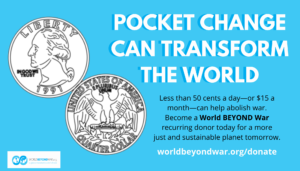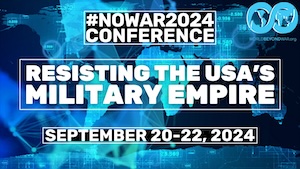By David Swanson, World BEYOND War, September 13, 2024
Remarks and slide show prepared for the 8th International Peace Summit of the Global Alliance for Ministries and Infrastructures for Peace (GAMIP) September 13, 2024, Abuja Nigeria.
The first thing we need to obtain and maintain peace is investment in the education and activism that prevents wars and that ends occupation and misgovernance without making use of wars. When the people of Bolivia prevent a coup or the students of Bangladesh overthrow an abusive government or people in African nations stop their governments from supporting French or U.S. military presence, we can begin to picture what is needed.
When popular pressure in Western nations prevents a war on Iran or an escalated war on Syria or the expansion of the Ukraine war into World War III, we are reminded that without popular resistance to warmongering — particularly of the nuclear sort — there would likely be no life on Earth. When the Israeli Finance Minister says he’d like to starve 2 million people to death but the world won’t let him, the world should take a bow and resolve to do much more of what it is that won’t let him.
When we see people oppose in opinion polls wars that their governments and major media outlets have told them to support, we must recognize educational successes; and when we see people accept war propaganda, we must recognize educational failures.
The infrastucture that we need to end war is absolutely not what the U.S. government or NATO would tell you. It is not the Pentagon. It is not the massive international weapons dealers. It is not the empire of foreign military bases. It is not a peace pole on display in the Pentagon as a proclamation that peace can and must be made through war.
It is also not something like the U.S. Institute of Peace, with its weapons company funders and board members, its dependency on the U.S. Congress and U.S. military, its refusal to oppose U.S. warmaking or war spending, its active support for war in Syria and Iraq, its opposition to negotiations in Ukraine, its silence on Gaza.
But perhaps it could be if the U.S. Congress supported peacemaking. And perhaps the U.S. Congress would support peacemaking if bribery were banned in U.S. elections, or U.S. schools were better, or the U.S. had better media outlets, or other nations refused to support U.S. wars, or peace activist and peace-education groups became more powerful — the public became more active.
It’s imaginable that the U.S. Institute of Peace could, if the Congress or public became somewhat more peace oriented, assist at critical moments in nudging things further in that direction. The institute could produce Congressional testimony, media interviews, op-eds, blog posts, and non-public advising oriented against war and toward peace, even putting its funding and future at risk. Thus far, we haven’t seen that. In 2015, the U.S. and global public, and even some members of the U.S. Congress — including the guy now running for Vice President for the Democrats — pushed back successfully against President Obama’s proposal to massively escalate the war in Syria. As far as I know, the U.S. Institute of Peace did not help. Perhaps the closest the institute has come to opposing U.S. war-making has been its commentary on Iran which has not been entirely opposed to diplomacy and agreements, even while about half of the U.S. Congress has been passionately opposed to anything other than hostility, sanctions, and war.
It’s arguable that the U.S. Institute of Peace has thus far been the opposite of helpful. As an official arm of the U.S. government, it proclaims itself an expert at peacemaking. It depicts opposition to genocide as a justification for U.S. wars and as not inclusive of opposition to those U.S. wars and U.S.-armed wars that are genocides. While we all watch a genocide livestreamed from Gaza, our official experts on opposing genocide say not one word against it. They teach us to look for the causes of violence in the backward cultures of non-Europeans, and to avoid any consideration of the U.S. weapons business, U.S. military training, or U.S. bases occupation. Might it not be more helpful to replace the U.S. Institute of Peace with some trees?
What if there were something else within the U.S. government with the name “peace” on it, a ministry or what in the U.S. would be called a department of peace? One could imagine it as a U.S. Institute of Peace with a bigger budget and bigger headquarters. One could imagine it without the Secretary of War — nowadays mislabled the Secretary of Defense — on its board. One could imagine it without weapons company funding, and with a ban on employing anyone funded by a military, a military contractor, or a non-U.S. government with a military. One could imagine Congress placing its funding out of reach of Congress, making it non-discretionary. If it had a cabinet-level secretary, he or she would have to be nominated by a president and confirmed by the U.S. Senate. So, the thing could end up being run by an opponent of its very existence. Or it could end up being run by a strong advocate for peace who was generally ignored by the rest of the government. But it’s also just possible that it could end up helping the cause of peace.
Similarly, existing and potential Ministries of Peace in any other nation — as well as other ministries or departments that are willing and able — can advance the cause of peace. On the topic of “Curbing Racism, Ethno-Religious intolerance & Promoting Social Cohesion” such ministries can do work focused internally that does not directly oppose a government’s foreign war agenda, and yet educate people to resist the bigotry and dehumanization that war propaganda depends on.
Civil society in the United States could, right now, establish a heavily funded Shadow Department of Peace, with a shadow Secretary of Peace with various deputies and a massive staff. It could demonstrate what an ideal official department of peace would do. It just wouldn’t have the same official status. This has been tried before; I’ve been part of it before — but without any funding at all, much less a marble palace on Constitution Avenue. Other nations that have ministries of peace, or where people can establish shadow ministries of peace, could provide models of what can be done. Here too, the work of “Curbing Racism, Ethno-Religious intolerance & Promoting Social Cohesion” could be advanced, perhaps most of all internally within a nation, but with implications for people’s willingness to believe future war lies.
I mentioned that one path to a peaceful U.S. might include the world saying no to U.S. wars. The infrastructure that we need may include the International Court of Justice, as well as the activist movements, the bodies within various governments, and the governments of nations like South Africa that have moved the court to order Israel to cease its genocidal actions in Gaza. But something more is needed because Israel has not done so.
The infrastructure that we need may include the International Criminal Court, where the prosecutor has been moved to finally request arrest warrants for top Israelis and Palestinians. But something more is needed because the ICC has not issued the warrants, as it has never issued any warrants for any Western war criminals and has prosecuted only Africans, giving the infrastructure of global justice a bad name.
The infrastructure that we need may include a United Nations General Assembly willing to use the “Uniting for Peace” Resolution 377 that allows it to act when the Security Council fails. The General Assembly could convene an emergency session and use “Uniting For Peace” to impose an arms embargo and targeted sanctions on the Israeli government, suspend the Israeli government from the United Nations, and send to Palestine unarmed peacekeepers (who have repeatedly shown their superiority to armed peacekeepers). Or, in the absence of collective courage sufficient for that, the infrastructure we need to build may consist principally of taking away the veto in the Security Council.
Another part of the infrastructure we need is national and UN unarmed civilian defense corps, or rather agencies engaged in training the public in unarmed civilian defense. This can defend a nation as well or better than a military. The main problem is that national governments do not want their people to know how to resist bad governance. Unarmed peacekeepers have succeeded for the UN in Bougainville where armed ones failed, and have succeded for groups like Nonviolent Peaceforce. Moving the UN out of armed militarism and into unarmed peacekeeping is a key infrastructural change.
We also need the infrastructure of conflict resolution through the International Court of Justice, the UN, and basic diplomacy. We need diplomats trained in peacemaking, not weapons dealing, and trained in diplomacy, not simply wealthy people who bribed politicans by funding election campaigns.
We need cultural institutions that honor peacemaking, award peace prizes to those actually deserving, thank peacemakers for their service, and celebrate the courage of unarmed resisters.
We need the upholding of treaties, and most especially Article VI of the Treaty on the Nonproliferation of Nuclear Weapons, which reads: “Each of the Parties to the Treaty undertakes to pursue negotiations in good faith on effective measures relating to cessation of the nuclear arms race at an early date and to nuclear disarmament, and on a treaty on general and complete disarmament under strict and effective international control.”
As well as of the Kellogg-Briand Pact which reads, in part: “The High Contracting Parties agree that the settlement or solution of all disputes or conflicts of whatever nature or of whatever origin they may be, which may arise among them, shall never be sought except by pacific means.”
Upholding these two treaties, and adding any additional or redundant treaties desired, would mean banning armaments and war. The process would involve a reverse arms-race and the infrastructure of verification, as well as new infrastructure made possible by demilitarization — infrastructure of cooperation on the non-optional crises of environmental collapse, homelessness, poverty, and disease.
In addition to newly strengthened and expanded global infrastructure, we need the same in most parts of the world for local infrastructure, as too much has gone into the medium-level, the national level of institution building. We need improved infrastructures for local democracy and for representing each level of population better at the higher level, up to and including the global.
Critically, we also need dramatically improved and more accountable systems of communications, free of for-profit monopolies. We need systems of communication and of education that orient us toward identifying with global citizenship, with rejecting policies of discrimination against refugees because they are us, and with refusing policies of war because they are attacks on ourselves.
##





























